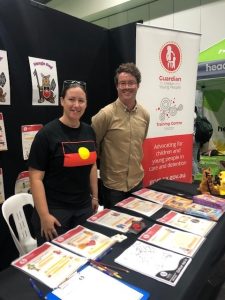
Last week, we had the privilege to take part in Closing the Gap Day, presented by Sonder and Nunkuwarrin Yunti on Kaurna Country.
The Office of the Guardian is strongly committed to Closing the Gap for First Nation children and young people in care and youth detention, so we took the opportunity to head on down to Closing the Gap Day to talk to children, families and community about what our office can do – to help make sure that First Nations children who are in care and youth detention get the support they need to thrive. Our staff met some amazing young people, families and carers, and had some good conversations about the rights of children and young people in care and youth detention.
Our factsheet on the right to Connect with Culture was very popular! First Nation children and young people have a fundamental human right to connect with their cultures, families, and communities. This right is protected by law. And that means the South Australian government has a responsibility to ensure that First Nation children and young people in care and detention are supported to:
- know about their family and heritage
- connect with Country, family and community
- learn about, and engage with, their culture
- feel proud, safe and strong in their identity.
We know that children who grow up safely, supported by their families and communities, live longer, healthier and happier lives. That’s why supporting cultural connection for First Nation children and young people in care and detention is at the heart of Closing the Gap.
For our office, Closing the Gap means refusing to accept poor outcomes for First Nation children who grow up in care and/or experience youth detention. Children and young people are not a disproportionality ratio; they are individuals with unique stories, aspirations, families and needs. We believe in each of their own personal daily achievements, their very own hopes for the future and the strength of their families and communities to walk with them on their unique journeys.

But Closing the Gap also means facing hard truths. In South Australia, we have fallen behind – in our laws, funding arrangements, and systemic efforts to keep First Nation children and young people connected to their families and communities. The blunt reality is that the overrepresentation of First Nation children in out-of-home care and youth detention is worsening; for too many children and young people, this is a story of sharp, sudden disconnection and social and cultural isolation.
Last month, we highlighted the launch of the Aboriginal and Torres Strait Islander First Action Plan, under the national Safe and Supported framework. Our office also welcomes the recent publication of the associated Aboriginal and Torres Strait Islander Outcomes Framework. The Framework recognises that culturally safe and prevention-focused systems, led by First Nation organisations and communities, is the only way to meaningfully reduce the overrepresentation of First Nation children and young people in the child protection and youth detention systems.
We look forward to seeing the transformation here in South Australia, where intentions translate into real and tangible outcomes for First Nation children and young people.
